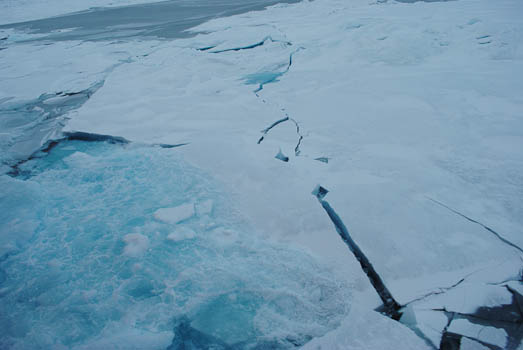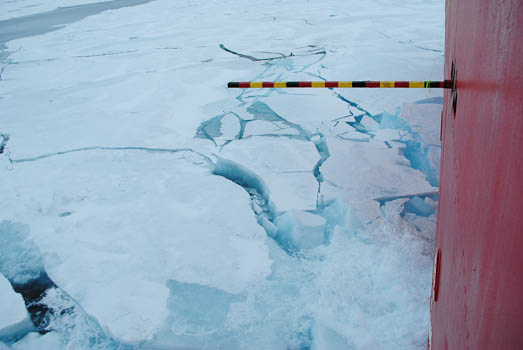Alex KainSeptember 24, 2009
Sea ice comes in a brilliant spectrum of blue and white hues. Its many forms--sometimes jagged, sometimes smooth--could easily replace Rorschach tests in a psychiatrist's office. Though different in size and character, one feature of all floes remains consistent. The ice, when colliding with the hull of the Louis, vibrates the ship and resounds. At times the collisions produce the sustained rumble of rolling thunder. Other times the sensation is more akin to the sudden and violent beating of a kettle drum. The sounds produced by the ice collisions are as varied as the shapes and sizes of the ice floes themselves. When the floes are moderate in size, the Louis easily breaks through, sending overturned fragments floating by the side of the ship. When encountering thick sheets of brittle ice, the enormous chunks crack, snap, and boom against the hull, sending ocean water splashing to the deck and crew members gripping the handrails present in every hallway. Often the ice sounds like metal bending and crashing into a chaotic mess. According to Mike Dempsey of the Canadian Institute of Ocean Sciences, the clamor sounds like "a continuous train wreck. It's like lying next to a 737." The din reminds Dan Carlson of the University of Alaska-Fairbanks of another sound common to northern environments. He says that ice crashing against the ship sounds like a snow plow dragging an 800-pound sled down a gravel road. The Louis runs twenty-four hours a day. The collisions with ice fill the nighttime hours with a loud grumble that causes restless nights for those, like many new scientists on board, who have yet to acclimate to the noise. The icy racket pervades every room and hallway of the ship. Ice expert Alice Orlich, who spends several weeks on ice-breaking vessels every year, characterizes the ice as "relentless." She describes it as the over-amplified boom you hear when diving into water and your head is enveloped in sound. Though the majority of those on board regard the ice as a nuisance to which you must acclimate in order to stay sane, some find the rocking and crunching to be a comfort. Kris Newhall, a technician with WHOI, finds the constant crunching soothing. "I've never slept better on any other ship," he says. Daryl Tobin, a cook on board, describes the sharp echoes as beautiful. The ice is fierce. It retaliates against boat intrusions by showing its natural might. Coast Guard Cadet Leann Morgan recognizes the ice's inherent power. "Some floes will send you across the room--they fight back," she says. WHOI's Jim Dunn notices a sharp contrast between the roar of traveling through icy water and the tranquility of still seas. "When you transition from ice cover to open water, you think you're going to fall off the face of the earth," he says. "You forget how the ship floats. That contrast exemplifies a duality that exists in the Arctic. The environment can be perfectly still, like on a windless night when the ship has stopped and every particle seems to be frozen in time. Yet contained within that still setting is tremendous force. The morning after that motionless night, the wind can howl, ocean currents can send twenty-ton ice floes crashing together, and an underwater block of ice, invisible to anyone standing on the ship, can smack into the hull and knock everyone to their knees. The dualism is part of what makes the Arctic so strange and spectacular. It is a place that can sustain frost flowers, the most delicate of natural forms that occur when atmospheric water molecules freeze to each other in a flower-like shapes, but also dense, monstrous icebergs that dwarf most suburban office buildings. As odd and extreme as this ice-covered world is, for some people aboard the ship it brings back memories of home. While describing the intensity of breaking ice, one sailor remarked with a smile, "it's like the wind howling during a vicious storm...or my wife when she's angry." All text and photos property of Alex Kain. Last updated: October 7, 2019 | |||||||||||||||||||
Copyright ©2007 Woods Hole Oceanographic Institution, All Rights Reserved, Privacy Policy. | |||||||||||||||||||




